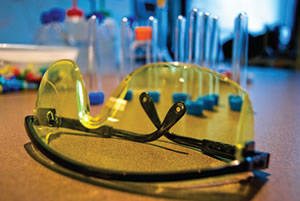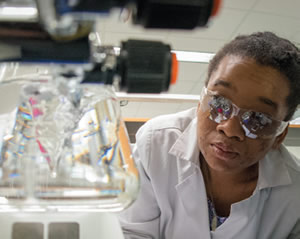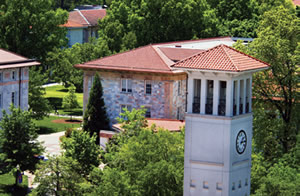Breathe Easy

PHOTO COURTESY OF SCOTT HEFFIELD
“Environmental Health and Safety (EHS) is a programmatic management approach to ensuring that activities undertaken by an organization are done in such a way as to protect individuals, property and the environment from harm,” says Jack Voorhees, executive director of Campus Safety, Health, and Environmental Management Association (CSHEMA), based in Bloomington, IN. “In the case of EHS in higher education, this generally means that research is being conducted safely and complies with all relevant state and federal guidelines, that students are learning and living in environments that are designed to be safe and conducive to their development, that employees can work without being exposed to hazards or injuries and that planning is done to minimize any impact should something go wrong.”
With that said, why should higher education administrators care about EHS?
“After a couple of high-profile accidents in research laboratories,” says Voorhees, “there has been much focus on creating a culture of safety on campus. Investigations into these accidents found that one root cause was that attention to safety procedures was lacking. The suggestion was that, had proper procedures been followed, the accidents might not have happened. In response, EHS has taken the notion that having a solid culture of safety is of utmost importance and, as a result, we have seen many novel approaches to improving safety culture. In organizations that can sometimes be large, complex, diverse and rooted in tradition — such as college campuses — this is a task that is easier said than done. Additionally, while it is unfortunate that accidents prompted action, it is exciting to see the renewed sense of commitment in this area.”
The experts indicate that there are two ways to ensure that EHS protects individuals, property and the environment from harm: best practices and risk assessments. Here’s a look at both.
Best Practices
Best practices are critical to keeping a campus environmentally healthy and safe. “Colleges and universities are hotbeds of development and research,” Voorhees states. “While good for advancing society, this sometimes creates interesting safety situations for EHS professionals to address. Procedure manuals are informed not only by state and federal regulations, but also by responding to the new ideas, approaches and initiatives that are common on campus. Our members, in turn, share those best practices with each other so that others don’t have to reinvent the wheel when a similar situation arises on their own campus.”
In addition to CSHEMA, there are numerous other organizations that develop internationally recognized standards for EHS. “The National Fire Protection Association, as an example,” Voorhees says, “has a comprehensive list of codes and standards that ensure safe building design and construction that protects human life and property. Similarly, the International Code Council develops model codes and standards used to construct safe, sustainable, affordable and resilient structures. EHS professionals use these and other standards to inform decision making.”
Patty Olinger, RBP, assistant vice president of the Office of Research Administration and executive director of the EHSO at Atlanta-based Emory University, adds to Voorhees’ already impressive list. She includes these organizations: Centers for Disease Control and Prevention (CDC), Biosafety in Microbiological and Biomedical Laboratories (BMBL) and National Institute for Occupational Safety and Health (NIOSH). She also includes professional associations on her list of places from which best practices are drawn, including APPA: Leadership in Education Facilities (APPA) and American Biological Safety Association (ABSA).

PHOTO COURTESY OF USDA
In addition, Emory’s EHSO relies on other sources for best practices. According to the website, “EHSO has university-wide responsibility for developing, implementing and maintaining EHS programs to control occupational exposures and to oversee the implementation of the mandated federal/state laws, regulations and guidelines promulgated by the Occupational Safety and Health Administration (OSHA), the Environmental Protection Agency (EPA), the Georgia Department of Natural Resources (DNR) as well other relevant agencies.”
“These are all really great avenues for networking, too,” Olinger says, “and that’s critical in today’s world. There are so many guidelines and best practices that are available, and it’s the networking that helps us keep abreast of changes. If you’re networked and you get a question not in your technological expertise, you can tag someone to learn where to go for more information.”
Part of the EHS challenge is to look at your own needs, sift through all the available best practices and apply what works best for your campus. This takes teamwork. “I couldn’t do my job without our critical preparedness group, the facilities department, the grounds maintenance department, the fire protection staff,” says Olinger, who is also a member of the CDC External Advisory Board, a member of the APLU/AAU–Lab Safety Task Force, past president of CSHEMA and past board member of American Biological Safety Association (ABSA). “It’s a team effort, one in which everyone brings a piece of the puzzle and, together, our communities are safer.”

PHOTO COURTESY OF EMORY UNIVERSITY
Risk Assessments
The second component to ensuring that EHS protects individuals, property and the environment from harm — risk assessments — tell you what risks are present and the potential for something to go wrong.
“Knowing that information,” says Voorhees, “you can plan to mitigate those risks and develop procedures in case something goes wrong. Most EHS professionals are intimately familiar with the ‘Plan-Do-Check-Act’ methodology that emphasizes continuous improvement of an EHS program — in other words, the job of creating and maintaining safe learning environments is never done.”
Olinger agrees, noting that building planning plays a large role in risk assessment. “Once you understand what work or activities will be or are being done in a building, you can then design it to protect users and contain the elements they’re handling. For example, if staff will be working with lasers, it’s critical to understand the shielding and eye protection lasers require. Similarly, if staff is doing tuberculosis research, ventilation must be properly designed to protect both the interior and exterior environments.”

PHOTO COURTESY OF EMORY UNIVERSITY
In addition to best practices and assessments, Olinger notes one other element about which campus administrators must remain diligent in order to ensure a top-notch EHS program: Communication. “We’re finding more and more that communication is critical to ensuring we’re moving forward,” she explains. “With all the technology and communication channels available today, it’s wonderful. But it’s also challenging because it changes so quick that it’s difficult to keep up.” She cites an example from her campus: “We are in the process of changing our spill team call outs because what used to work in the past doesn’t work like we want it to today.”
One solution the team discussed was having the emergency system make an automatic call to the entire team. Doing so meant that some staff had to update their cell phones.
“It seems like such a simple thing,” she continues. “And when you have a large campus, the little things can make a huge difference in terms of effectiveness. We’re challenged right now with making sure we’re communicating effectively and efficiently in today’s fast-paced world to ensure an environmentally healthy and safe campus.”
This article originally appeared in the issue of .